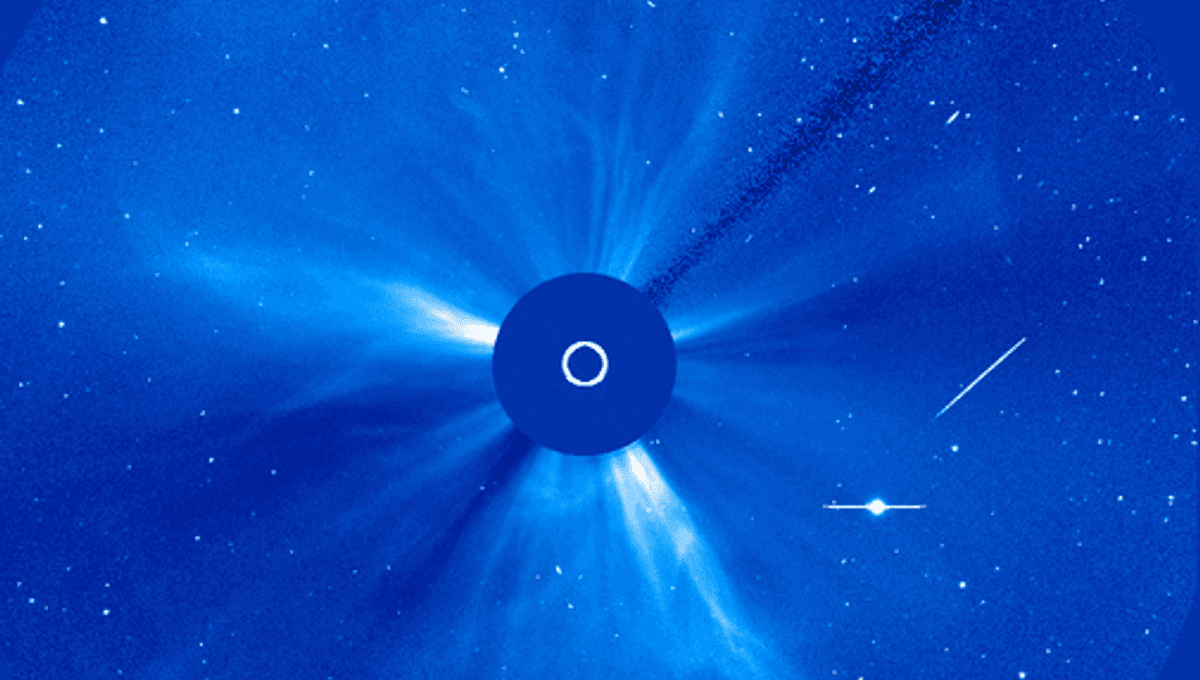
Late on Monday, March 13, the Sun blasted out a coronal mass ejection (CME) traveling at at least 3,000 kilometers per second (6,700,000 miles per hour), possibly the fastest ever recorded. The expelled particles reached the Earth’s orbit in less than a day. Had they hit the Earth, the results could have been catastrophic, but fortunately the CME was directed almost directly opposite. However, the explosion is a reminder the next time we may not be so lucky.
Despite coming from the far side of the Sun, it appears the event has caused a minor radiation storm on Earth. A smaller, and much slower, CME on Saturday that was predicted to graze the Earth may have also contributed. CMEs can affect each other, with one clearing a path for the charged particles from another. Spaceweather.com predicts shortwave radio failures for planes flying over the poles.
CMEs involve bursts of the Sun’s plasma and associated magnetic field being fired into space, usually in association with solar flares. CMEs are common, but most are too small to do major damage, and are usually not pointed towards Earth anyway. Preliminary estimates have yesterday’s event as being “extremely rare”, probably happening once or twice in several decades.
In 1989, a pair of CMEs and an X-15-class solar flare combined to fill the Earth’s magnetosphere with charged particles, causing auroras as far south as Florida and tripping Quebec’s power grid, and causing a nine-hour blackout across the province. On the scale of natural disasters that may seem small, but the solar activity that triggered it was minor compared to what we know is possible.
A much larger storm known as the Carrington Event in 1859 fried telegraph systems across North America. If it occurred today the consequences would be staggering, crashing electricity grids, dragging satellites from orbit and interfering with water supplies and the Internet. One model estimates the costs would be $2.6 trillion just in North America, but this could be slashed dramatically if preparatory action is taken.
How yesterday’s CME compares to the Carrington Event is not yet clear. To some extent it will never be, since in the 19th century we lacked the capacity to measure the power of such storms precisely. Nevertheless, there is little doubt a storm like the one we just witnessed could do plenty of damage to an unprepared Earth.
The Sun is approaching a maximum in its 11-year cycle. Despite many predictions that this cycle would be a mild one, the opposite seems to be the case. Already we are reaching levels of activity, measured by the number of sunspots and the strength of CMEs and solar flares, similar to the peaks of the last two cycles, and we could still be years away from the summit.
That being the case, the chance of a powerful CME pointing our way in the near future is considerably higher than usual. Long-term preparations for such an event can include upgrading infrastructure, but in most cases it is probably too late for that for this cycle.
If an outburst is coming our way there are more short-term actions that can be taken, such as shutting down electricity grids to prevent transformers overloading. However, the faster-moving a CME is, the less time governments and infrastructure companies have to make the decision whether to bear some temporary pain in order to reduce the risk of a major meltdown. Many may fear pushback from the same people who resisted pandemic interventions as restrictions on their rights.
There are wildly varying estimates of the risk of a Carrington-style CME hitting Earth, from around 1 percent in a decade to 12 percent. Palaeontologists have sought markers of such events using radioisotope records in tree rings and ice cores, hoping to work out how often they strike Earth, but the question is unsettled.
Source Link: Earth Just Dodged One Of The Fastest Coronal Mass Ejections Ever